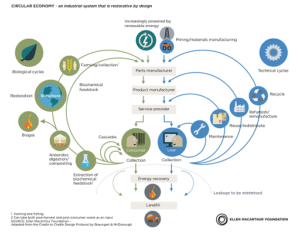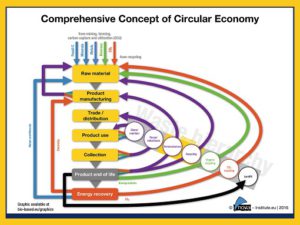Two concepts, the bioeconomy and the circular economy, have much in common but seem to belong to different universes. Proponents of the circular economy treat the bioeconomy as a fringe phenomenon, that circles around biodegradation; whereas the bioeconomy does not sufficiently value resource efficiency. Inadequate concepts will result in inadequate policies, like stimuli for biofuels rather than for biobased materials. But the unified term circular bioeconomy still needs much clarification. Or do we rather need a precision economy, in the end?

The technical and biological cycles are equivalent
Nova-Institute, the German institute that has already made many valuable contributions to the bioeconomy, made a brave attempt to find common ground between the circular and the bioeconomy. Its latest paper, released January 2018, is called ‘The Circular Bioeconomy – Concepts, Opportunities and Limitations’. The concept of the circular economy, as propagated by the authoritative Ellen MacArthur Foundation, explains that there are two cycles in the circular economy: the technical and the biological cycle. Almost all attention goes to the technical cycle, characterized by the words Share, Maintain, Reuse, Remanufacture and Recycle. The object of these actions (in this order) is to maintain the economic value of products, materials and resources, as long as possible. And in doing so, use resources to the maximum and reduce the amount of waste to a minimum. The main biological cycle on the other hand runs through degradation of agricultural side streams, providing the mineral and biological resources for new agricultural production. But, as nova-Institute puts it, ‘in reality, the majority of bio-based products enters the technical cycle and only a small share enters the biological cycle (biodegradation)’. Think, for instance, paper and pulp. And biobased chemicals and plastics. So at least, some balance needs to be restored. Will this lead to valuable insights?

Images tell half the story. Nova-Institute proposes a new image to replace the two-winged ‘butterfly’ image of the circular economy. There is just one circle, nova-Institute proposes, that contains many processes, like reuse and recycle, but also biodegradation. The input consists not just of fossil feedstock, minerals and metals, but also of biomass, and, as nova adds, CO2 that can also be processed to useful products. Organic recycling is one of the many circles in which mankind can restore value. All this is not to downplay the importance of the circular economy (‘the circular economy has huge potential and is crucial for a sustainable world,’ according to nova-Institute), but to reformulate it so as to produce the circular bioeconomy.
Biomass, use it efficiently or not?
The bioeconomy, according to the definition given by the European Commission, ‘comprises those parts of the economy that use renewable biological resources from land and sea – such as crops, forests, fish, animals and micro-organisms – to produce food, materials and energy.’ Now this is a very broad definition. But it is generally acknowledged that, both for economic and for environmental reasons, the bioeconomy should ‘cascade’ its use of biomass: process biomass in such a way that predominance is given to the most valuable components, then to the others, in order of their value. This principle bears much resemblance to the ‘share, maintain, reuse, remanufacture and recycle’ idea of the circular economy, likewise intended to use resources to the maximum and reduce waste to a minimum. ‘The main target of (both) cascading and circular economy,’ says nova-Institute, ‘is an increased resource efficiency at less demand for fresh materials, with both of these frequently linked to added value and job creation.’ But oddly enough, the principles of the circular economy do not resist the once-through use of biomass to energy (or fuels), the option preferred by policy in the US and Europe. ‘It is a paradox situation,’ nova-Institute tells us. ‘Before the biomass becomes a biobased product, incentives lead the biomass directly to energetic use, while after the biomass has been turned into a bio-based product, incineration is only the least preferred option in the waste hierarchy.’
In search of the circular bioeconomy
Nova-Institute, in search for the circular bioeconomy, then proceeds to map the similarities between the circular economy and the bioeconomy:
– improved resource and eco-efficiency
– low GHG footprint
– reducing the demand for fossil carbon
– valorisation of waste and side streams
And then, the differences:
– many products of the bioeconomy do not lend themselves to the principles of the circular economy: food and feed, bioenergy and biofuels, and many cosmetics, paints etc.;
– and many new developments in the bioeconomy escape the framework of the circular economy, like new developments in agriculture and forestry (precision farming, gene editing), and new processing pathways with lower toxicities and milder chemicals, leading to products with new valuable properties.
Michael Carus, the director of nova-Institute, once summarized their position as follows: ‘biomass flows are part of the circular economy, but the concept of the bioeconomy is much more than the circular economy can cover.’ And, in the present nova-paper: ‘the circular economy is not complete without the bioeconomy and vice versa. The huge volumes of organic side and waste streams from agriculture, forestry, fishery, food & feed and organic process waste can only be integrated in the circular economy through bioeconomy processes, while the bioeconomy will hugely profit from increased circularity.’ The circular bioeconomy, the combination of the two, will result in a much better utilization of biobased side streams, and eventually in linking different industrial sectors, like the food & chemical industries (not foreseen in the circular economy, but a major opportunity).
Towards the precision economy
But in the end, the circular bioeconomy defined in this way is just the overlap between the bioeconomy and the circular economy, each having a space of their own that is not related to the other. In search for an inspirational economic concept producing an economy that is both profitable and sustainable, all these concepts lack essential elements. In fact, we feel that there is a better concept that provides an outlook on a new economic ethos; we wrote an entire book on it. That is the precision economy: the economy in which technology produces precisely what is required and nothing else; reinforced with social arrangements tuned to that goal. An efficient economy that produces as little waste as possible, and that extends into many sectors like energy, agriculture and horticulture, new materials, industrial process technology, the search for new medicines, and more. The precision economy, a concept that encompasses both the bioeconomy and the circular economy.
Interesting? Then also read:
Circular economy: do not merely close the chain, slow it down as well
Bioeconomy, circular and small-scale. Really?
Biorefinery as the key to the circular economy
